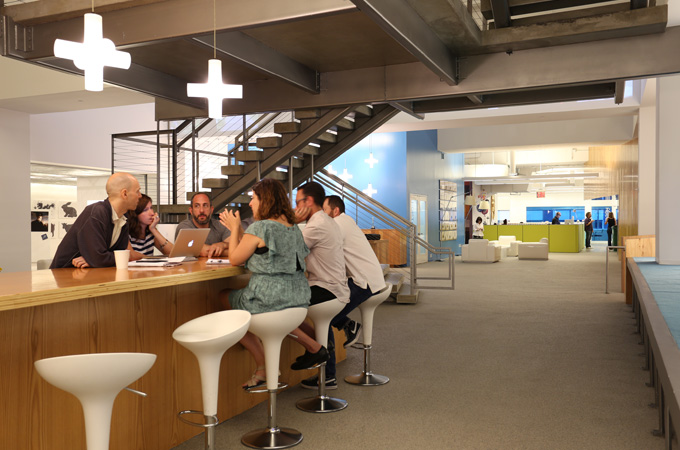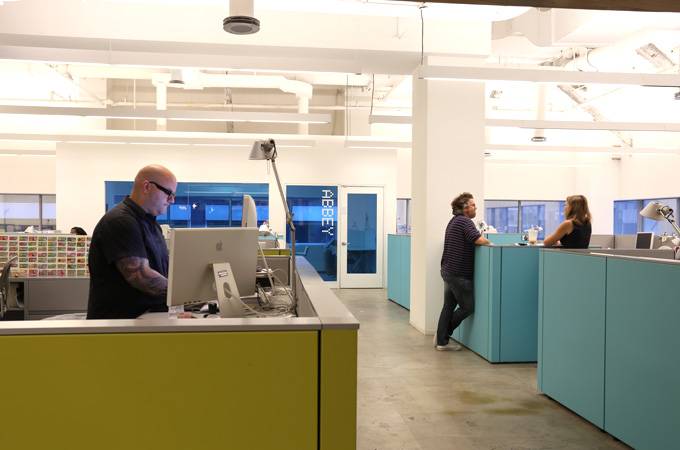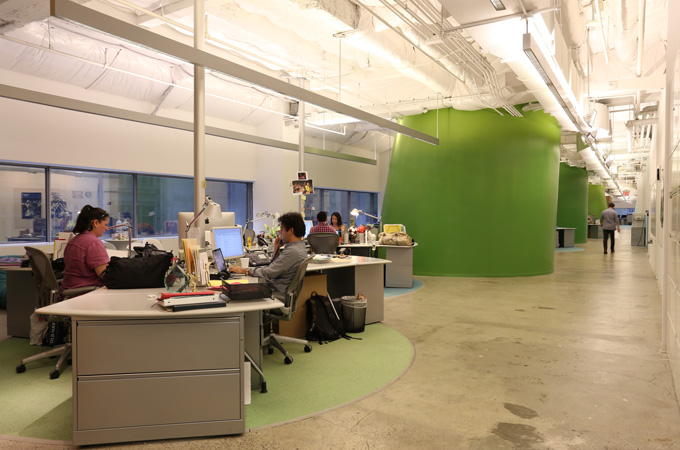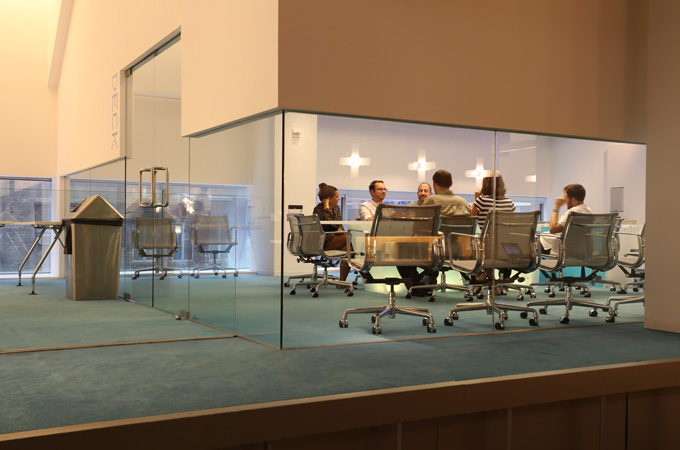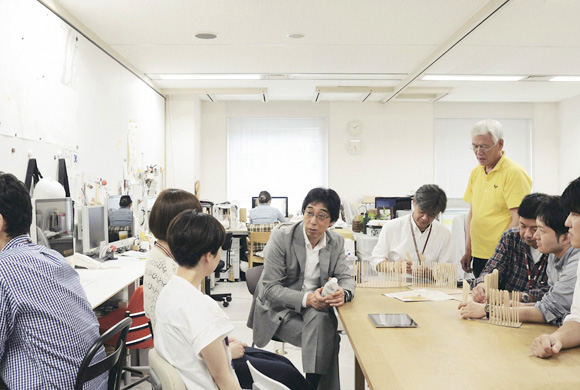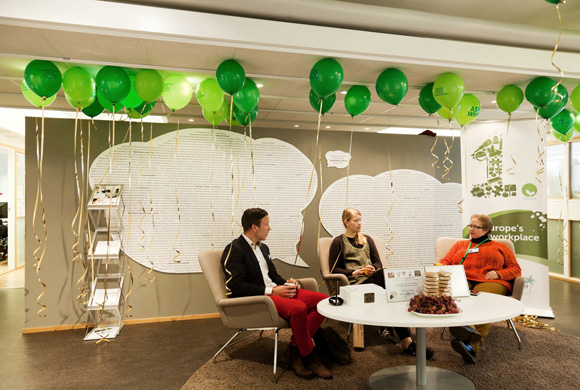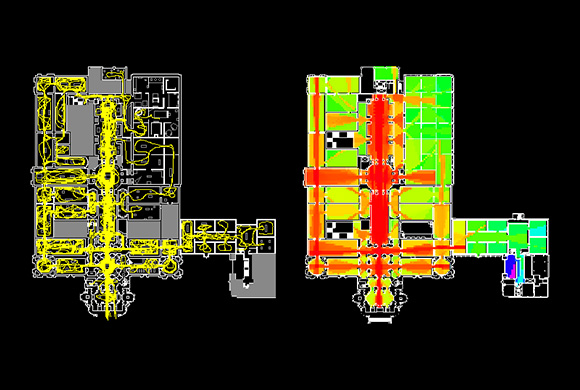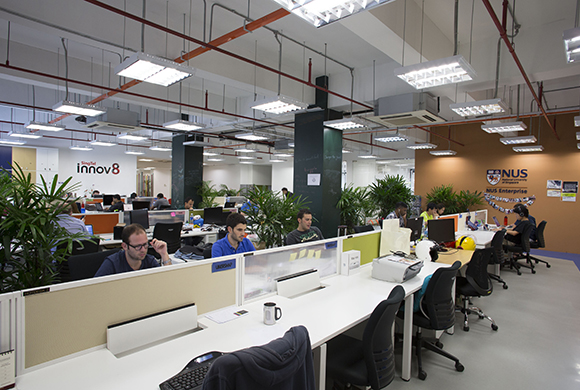Workplace
Jan. 6, 2014
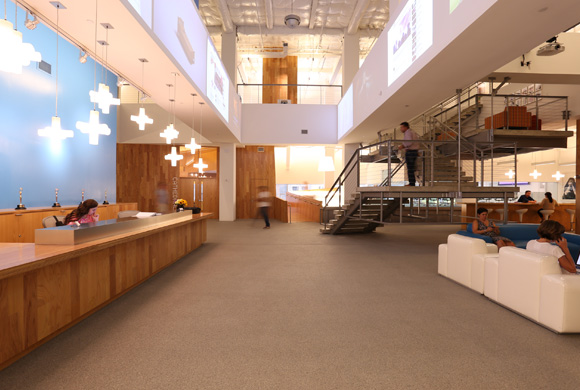
A space that stimulate the basic senses and helps create ideas
An advertising agency with offices in 90 countries
[JWT] New York, USA
Since JWT’s founding in 1864 in New York as the world’s first advertising agency, it has continued to grow whole producing advertising in every field, covering all kinds of topics. Today it has more than 200 offices in over 90 countries, making it a true global advertising agency.
JWT’s headquarters in New York is the largest of all its offices, with 700 employees, including freelancers and part-time people, working in five stories of a building. A design change in 2004 converted the office space to an open floor layout.
Walking from the reception area into the office, the thing that is surprising is that it seems not to be like a company at all, but has an open feeling that is more like walking around outdoors. Only three top executives have private offices. Apart from the sixth floor housing the personnel department, the central stairs serve as a place for communication. Apart from the area prepared for each employee in their own department, staff engaged in a project can look for their own space in which to work with the other members of the project.
We wondered about why it was important to make such a fundamental change in an office that formerly was very “businesslike.” “We stopped having spaces that reflected each person, and thought it was more important to create a space that would improve collaboration between people,” says Eric Weisberg, Executive Creative Director.
Five years ago in the advertising business, the media was largely limited to television, radio and print, and it was enough to cover between three to ten media outlets. Today, though, Internet advertising, mobile messaging and other new media have grown to be about half of JWT’s work. This means that now some 300 media will have to be covered, so in the majority of cases many people will be involved in a wide range of projects. To create the collaboration that will distinguish it from other companies, JWT saw that an office that could more organically result in the dynamic flow of ideas would be needed.
“In our previous office, it was enough to have a comfortable room where two people could meet to polish up their ideas,” Mr. Weisberg says. “Today, though, we need a space where between three and ten people can come together to work.” In the previous office, he says, there were many small meeting rooms lined up on either side of a rather dark corridor. These clearly divided space into “inside” and “outside,” with ceilings just three meters high—quiet spaces that were definitely not a place for dynamic decision-making.
With the remodeling, this all changed to a brighter, more energetic space. Thanks to this, the number of floors used in the building were reduced by one, while still providing a comfortable place to work for the same number of employees as before the renovation.
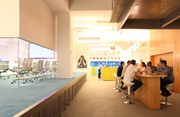 Established: 1864
Established: 1864
Headquarters: New York
Employees: Approx. 10,000
The fundamental nature of JWT is what it calls “Worldmade.” JWT’s creations are born from constant interchange with the rest of the world, and its strategies, ideas and productions are also based on inspirations gained from around the world. Without concern for national boundaries or regions, the company has a strong spirit of creative inquiry.
http://www.jwt.com/
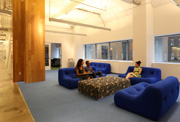 Regular meetings can be held at these sofas, or other such locations. In a suggestion from art-loving CEO Bob Jeffery, artwork is displayed on the walls in different locations, with the locations changing each quarter.
Regular meetings can be held at these sofas, or other such locations. In a suggestion from art-loving CEO Bob Jeffery, artwork is displayed on the walls in different locations, with the locations changing each quarter.
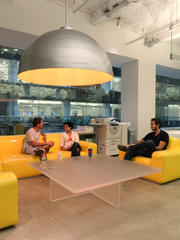 The colors and materials used vary according to floor, providing a wide range of changes. Employees can find the place with the colors to match their feelings and work there.
The colors and materials used vary according to floor, providing a wide range of changes. Employees can find the place with the colors to match their feelings and work there.
With the change to this kind of office, the various team’s work also became more flexible, better able to cope with change. “Work previously was very linear,” Mr. Weisberg says. The creative people came up with an idea, which was then taken over by the person in the strategy department and presented to the client. If they got the OK, production work would begin, to be taken up by the traffic staff who would actually deliver the work. Today, however, the linear approach to work can’t keep up with the speed of change. When dealing with technology, media and content, it’s better that team members knowledgeable in these areas be involved from the earliest stages. This allows for ideas to be generated, and collaboration to increase.
“Ideas today have to fit with the market, and if we can’t change quickly we can’t do work that meets market needs,” Mr. Weisberg says. “As we begin work, we use that process as we continue to make changes as we move toward our deadline, and it’s important that all processes be dynamic.” Today, providing solutions requires creativity, and how these solutions will vary in different markets is also a very important issue.
To accomplish this, a variety of people need to be able to find the place that is inspiring for them personally—a counter seat, a sofa, a desk, a tent—and this variety of places has been created in the office. The term “global company” brings with it a completely opposite image from an open, free and casual space. “Because the people who work in advertising agencies want to join in and participate in creating things, the office shouldn’t be a dignified, solemn place,” Mr. Weisberg says.
JWT is a place full of curiosity, Mr. Weisberg says, and of people who want to find solutions to global issues, so they want people who are passionate about telling this story. From Twitter and games to poetry, there are a great many ways in which this passion is expressed. The new office was born as a place where all these can be advanced.
“The goal of remodeling was a campfire,” says General Manager Angela Burton. In the old office there were many partitions, and people had to use the elevator to move between floors. To improve the sense of connectivity within the building, the idea was to create a feeling like that of sitting around a campfire, with people talking about what they wanted to.
“The keyword is story telling,” Ms. Burton says. “We wanted to create a space in which that story would naturally be born. The central staircase is a tree trunk, with the floors the branches. This was the idea of the company CEO, Bob Jeffery. Our hope was for an open area that could access the whole office, one that felt like being outdoors, a place where the staff could always return for communications. Through communication, everyone would think about the story. And that definitely is a campfire.”
As the renovation of the office progressed, the staff gradually adapted to the changes in the space. The first step was the removal of all 700 doors to private offices. This was the first stage before beginning the real construction work, and a kind of preparatory phase where people could begin to get accustomed to the open (door-less) work space that was being built. With just that, though, employees could now see right into each other’s offices, and exchanges of ideas and collaboration began. “During the construction, we got everyone sitting together in a big room to get them used to the idea of not having walls between them,” Ms. Burton says. “As work was being done on each floor, the employees would move to a different floor.”
There was a bit of an experimental element to the process, as some employees got used to the changes, while others were a bit more bewildered by them. But if this had been imposed as a top-down rule, then employees would have only accepted this as an obligation. “The leaders also work at the same desks and sofas as everyone else, showing that everyone is treated the same,” Ms. Burton says. “Because of this, other employees were able to adjust to the new environment.”
The floor for each department is decided, with accounting, production and creative people separately arranged, but the seating within a floor can be smoothly changed. The creative and strategic people working together on a project may sit next to each other; then, once the project is completed, the strategist might move to be next to a different creative team. “The space and people can quickly be interchanged for a new client or project, which is one of the wonderful things about this office,” Ms. Burton says. Six days are enough to create a whole new space. Practically, to ensure communication with the new people of different departments, changes of arrangement are made about once every year and a half, at fixed intervals.
The new JWT office also serves the role of a self-introduction for the company. When a client visits, they immediately understand what kind of agency it is, and can easily imagine what kind of people are working there. The spacious, colorful, dynamic office holds the promise of a high level of creativity. It stimulates original feelings, in a space that encourages basic communications and helps people bring out that “something new.”
Web-exclusive content
On 7th July 2013 interviews at the New York office
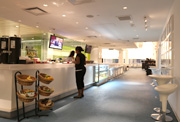 The cafeteria, where breakfasts and lunches are served. On Wednesday’s and Thursdays this becomes a bar with bartender; Thursday evenings feature all-you-can-drink beer. The cafeteria is also used for a variety of events.
The cafeteria, where breakfasts and lunches are served. On Wednesday’s and Thursdays this becomes a bar with bartender; Thursday evenings feature all-you-can-drink beer. The cafeteria is also used for a variety of events.
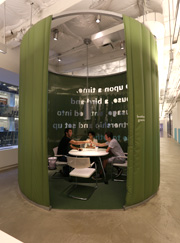 One of the tents used for meetings. These are named after authors, such as the Brothers Grimm and Mishima. The light leaks out through cutouts in the cloth that are taken from the writer’s texts.
One of the tents used for meetings. These are named after authors, such as the Brothers Grimm and Mishima. The light leaks out through cutouts in the cloth that are taken from the writer’s texts.


